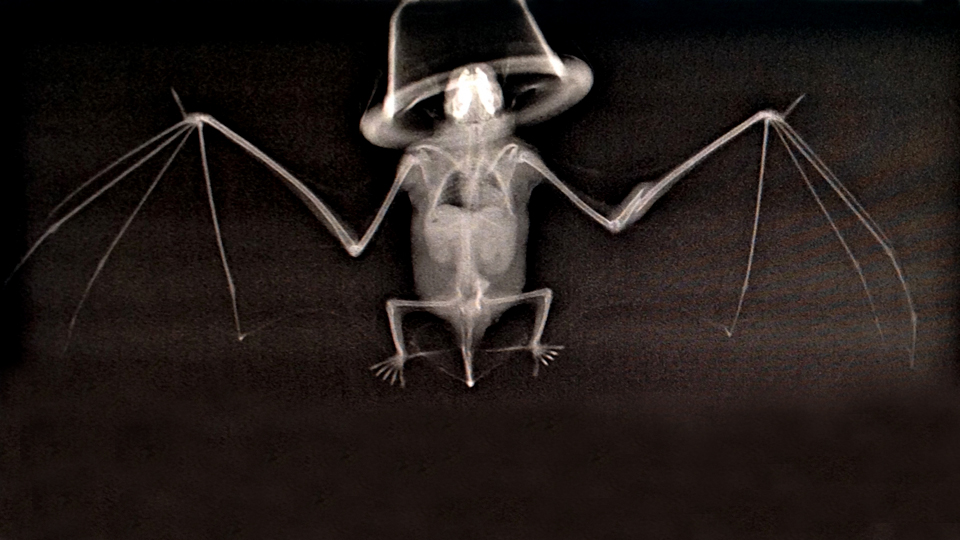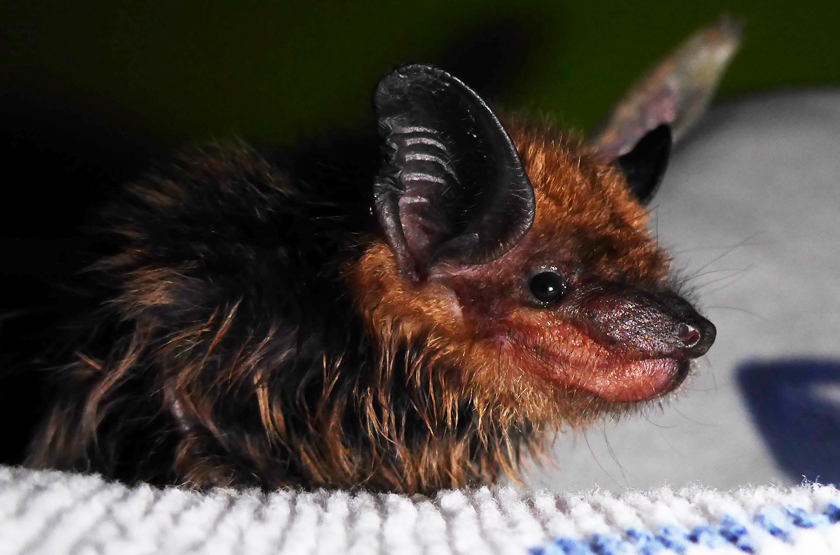Hoping For Bat Survival; Rooting For Feisty Ferdinand
By Vicki Croke
An X-ray of Ferdinand, a big brown bat with a broken arm who was brought to the New England Wildlife Center. You can see the partial outline of a mask used to administer a light flow of anesthesia during the X-ray. Courtesy of New England Wildlife Center.
He’s a survivor. And that’s a very good thing these days when we can use every bat we can get.
“Ferdinand,” is a big brown bat, (a slightly inflated name for a species that doesn’t even weigh an ounce), who was found with an injured wing and transported last week to the New England Wildlife Center in Weymouth. His surgery to set the fractured radius-ulna bone was successful. And now, despite his broken arm, and despite the fact that he is a fraction of the size of his caretakers, Ferdinand is ready for a fight every time someone at the Center tries to give him his meds.
Ferdinand in his makeshift hibernaculum. Courtesy of New England Wildlife Center.
“He’s feistier than any other bat I’ve ever worked with,” says Brodie Morris, a vet tech at the center where they treat about 15 injured or sick bats a year. “They’re usually annoyed at first, but then calm down while you’re handling them.” Ferdinand, however, “hisses, spits, and is basically stuck to your glove with his teeth the entire time.”
Morris clearly admires his pugnacious patient.
There’s a lot to treasure about these flying mammals in general. It’s estimated that their “pest control services” save U.S. farmers as much $53 billion a year, according to the U.S. Geological Survey.
“There’s nothing about bats that isn’t cool,” says Dr. Greg Mertz, the veterinarian who heads the New England Wildlife Center, a nonprofit, comprehensive wildlife hospital that treats sick, injured, and orphaned animals. He cites their echolocation abilities in navigating the skies, their nocturnal lifestyle, and their insect-ravaging powers, which are “absolutely one of our best defenses against all kinds of insects that can transmit disease to humans.”
“Even the way they pee is amazing,” Dr. Mertz says. Considering gravity, hanging upside down could make life more than a bit damp for an animal when releasing urine. “So they use their fingers, hold onto a surface,” and do a chin-up to right themselves. That keeps a bat clean and dry.
Dr. Mertz is an eloquent fan of saving just about any animal who comes in (they treat 225 species a year here), but bats, in particular, are in trouble. “They need help,” he says.
A photo of a little brown bat with white-nose syndrome taken in New York in 2008. Courtesy of Ryan von Linden/New York Department of Environmental Conservation/Flickr.
The numbers tell the story. About 90 percent of the bats in the northeast have been lost over the last few years, most of them to a fast-spreading fungus– Pseudogymnoascus destructans, or pd–which causes what’s called white-nose syndrome in bats. At least 7 million bats in 25 states and five Canadian provinces have died from it. And, according to one study, close to a million more may have been killed by wind turbines—hit by the rotors or slammed by the tempest they create.
According to the Organization for Bat Conservation:
Since the winter of 2006, White-nose Syndrome has killed more than 5.7 million bats in Eastern North America. White-nose Syndrome (WNS) is a disease caused by a non-native, cold-loving fungus which can be found in the caves of the affected regions. It was first discovered in New York caves during the winter of 2006-2007, initially killing half of the wintering bat population. The name of the disease refers to the white fungal growth found on the noses of infected bats, although it is also found on their wings and tail membrane.
The fungus is currently affecting hibernating bat species in nearly half of the United States and parts of Canada. It continues to spread across the continent. Little brown bats, once a common bat in several areas, are sustaining the largest number of deaths. Caves infected with WNS are displaying 90-100% bat mortality – wiping out most of the cave bat populations. The fungus can persist in cave sediment after bat colonies leave their hibernacula (caves or mines) in the spring, lying in wait to infect next winter’s arrivals. A Department of Environmental Conservation survey shows a 93% decline of little brown bats in 23 caves at the epicenter of WNS. Currently, seven other hibernating bat species are affected by the fungus: little brown bats, northern long-eared bats, big brown bats, tri-colored bats, eastern small-footed bats, the endangered grey bats, and the endangered Indiana bats. The disease is spreading rapidly and has the potential to infect at least half of the bat species found in North America.
Dr. Mertz says that, in the past, the center used to treat other species of bat too, like little brown bats, but he just doesn’t see them anymore. The population of little brown bats has been hit hard. Out of the seven species of bats in Massachusetts, only big brown bats, like Ferdinand, and red bats are routinely admitted to the hospital.
This map shows how widespread white-nose syndrome is. Courtesy of whitenosesyndrome.org
So even as scientists race to find a way to save millions of bats from big threats, some of these little lives are being rescued one at a time.
That’s the story with Ferdinand who doesn’t have WNS, but a broken bone. (To avoid anthropomorphizing, emotional attachment, or perhaps, in the name of science, some wildlife organizations don’t name animals. The Wildlife Center doesn’t forbid the practice, but still, laughing a little, and taking the middle road, Brodie Morris says he named the bat Ferdinand, but “I only call him that in my head.”).
Because this is the time of year big brown bats hibernate, Ferdinand will be kept over winter and released in the spring if he’s healed and ready to go. In the meantime, he can manage his makeshift hibernation as he likes. Home is a terrarium with a towel ceiling that he can grab and hang upside down from. He’s offered dog food and meal worms daily. The indoor room that will serve as his winter quarters or “hibernaculum,” is kept cool and dark.
Everyone is rooting for Ferdinand.
After all, saving bats is not only good for bats and the environment, it might be good for our souls. Have a look at this “bat burrito” video from Australia:
[youtube=http://youtu.be/Uuvaos1WHTk]





3 Responses to “Hoping For Bat Survival; Rooting For Feisty Ferdinand”
Ferdinand does look quite feisty! We hope for a cure this 2015 for WNS and for our batty populations to be restored.
Good news for the bats, good news for the environment.
There’s nothing about bats that isn’t cool, we have bats here in the summer that come to our large native fig tree. Many people don’t like bats but our family all think they are fascinating
It’s great to see more and more help for our sweet bats. Keep up the good work, and God Bless You ALL!
Comments are closed.